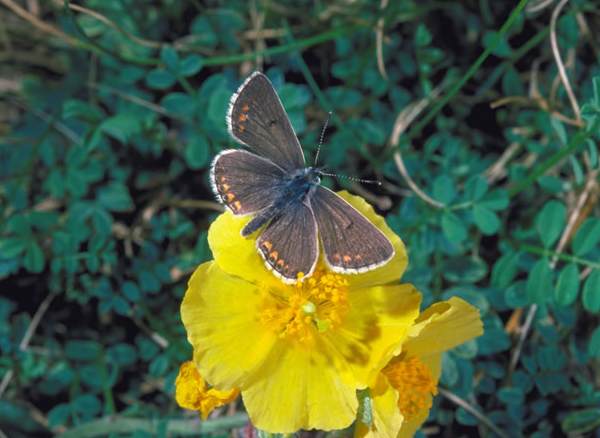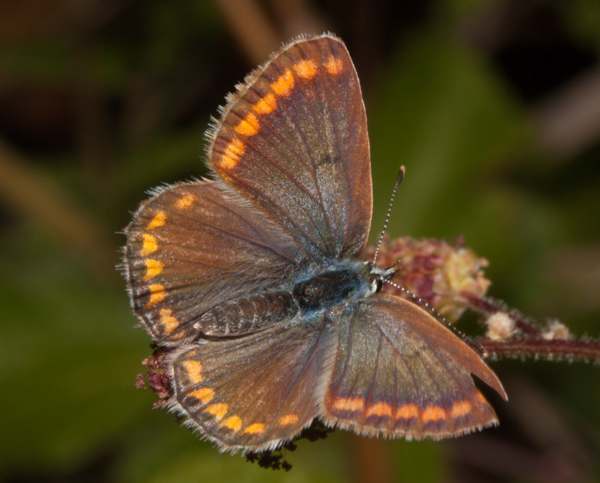Trees Birds Mammals Fish Amphibians Reptiles
Wild Algarve
Bookshop
Brown Argus Butterfly - Aricia agestis
Phylum: Arthropoda - Class: Insecta - Order: Lepidoptera - Family: Lycaenidae

The Brown Argus is one of the so-called 'blues' that has no blue scales on its upperwings.

Males and females are quite similar in appearance but females are nearer the upper end of the 2.5 to 3.1cm wingspan range, males being smaller.

The specimen shown above is the closely-related Aricia agestis f. cramera (syn. Aricia cramera) and was photographed in the Algarve region of Portugal.
Distribution
In Britain the Brown Argus is mainly concentrated in the chalk downland areas of central and eastern England, with scattered populations along the calcium-rich sand dune areas of coastal Wales but none in Ireland. Further north this species is replaced by the Northern Brown Argus, Aricia artaxerxes.
Elsewhere the Brown Argus can be found locally throughout most of Europe except Scandinavia. To the south its range extends into northern Africa and to the east this butterfly also occurs in parts of the Middle East and Asia.
Lifecycle
In northern and central Europe there are two overlapping generations of the Brown Argus; they emerge in May and in August, with the males preceding the females by a few days. On the Iberian peninsula and in Mediterranean countries there are normally three broods, the adults appearing in April, July and finally October.
The main larval foodplant is Common Rock-rose Helianthemum nummularium, although some members of the plant family Geraniaceae are also used occasionally. The pale eggs, laid on the undersides of leaves of the larval foodplant, hatch in about a week; then the tiny larvae eat the underside of the leaves so that just the upper cuticle remains in the form of shiny translucent patches.
As the caterpillars from the first generation develop, they are tended by ants that take honey dew from them. In Britain, when fully grown these green caterpillars with purplish stripes pupate on the ground in July, and their chrysalises are buried by ants. A week or so later the winged adults emerge.
Second generation eggs hatch in August, and the caterpillars feed for a short time and then go into hibernation right through the winter until March of the following year; then they resume feeding before by the end of March.
Acknowledgements
This page includes pictures kindly contributed by Rob Petley-Jones and by Betty and Tony Rackham.
Studying butterflies and moths...
Excited by rivers and streams? So are we, and we're pretty sure you would find the Winding River Mystery trilogy of action-packed thrillers gripping reading too. Dead Drift, Dead Cert, and Dead End are Pat O'Reilly's latest river-based novels, and now they are available in ebook format. Full details on our website here...
Buy each volume in ebook format for only £2.47 on Amazon... Paperbacks also available on Amazon at £6.95 each. All proceeds go towards keeping the First Nature website online.
Please Help Us: If you have found this information interesting and useful, please consider helping to keep First Nature online by making a small donation towards the web hosting and internet costs.
Any donations over and above the essential running costs will help support the conservation work of Plantlife, the Rivers Trust and charitable botanic gardens - as do author royalties and publisher proceeds from books by Pat and Sue.